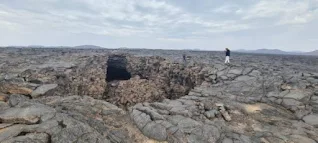In a few seconds, the Great Shaanxi Earthquake that struck China 468 years ago killed 830,000 people, making it the most massive earthquake in human history in terms of the number of victims.
This massive earthquake was estimated by scientists to have a destructive power of 8.7 degrees, and its epicenter was in Shanxi Province, which is one of the most densely populated areas in China, and was also a center for commercial and agricultural activities.
In the early morning earthquake of January 23, 1556, some villages were completely leveled, leaving only a few residents alive. Others died in the following days and weeks, with millions more seriously injured.
The epicenter of the earthquake was specifically in the Wei River Valley, which is the right tributary of the Yellow River, and is located in the Huazhou District of Shaanxi Province in northern China.
Earthquakes were not uncommon in the Wei River Valley, as it was located within three major fault lines, and the region had witnessed at least 26 earthquakes before, but the earthquake of 1556 was different and extremely destructive.
This earthquake has different names: “Jiajing” because it occurred during the reign of the emperor who bears that name, and the Chinese earthquake, but mostly it is called the Great Shaanxi Earthquake.
The earthquake significantly affected more than 97 Chinese provinces, including Shaanxi, Shanxi, Henan, Gansu, Hebei, Shandong, Hubei, Hunan, Jiangsu and Anhui, while the force of the earthquakes was embodied in cracks and holes in the ground reaching a depth of 20 meters, which were immediately filled with water and mud carried by mud torrents. Residents drowned in swampy soil, and the devastation could be seen within a radius of 850 km from the epicenter of the seismic disaster.
In Shanxi Province, more than 60% of the population were killed, and some areas were completely evacuated of residents, while this huge number of victims was due to the fact that most of them lived in buildings that were not resistant to earthquakes, and in earthen caves dug into the slopes of hills of sedimentary rocks. , which collapsed with the first tremors, in addition to the fact that the earthquake struck the residents early in the morning.
At the time, it was thought that staying indoors during an earthquake was a safe option, so many residents died without trying to emerge from their shelters, while buildings that survived, such as the Wild Goose Temple in Xi'an, had their foundations sunk two meters into the ground.
The Portuguese monk Gaspar da Cruz, who was at that time visiting China, wrote: “In the winter of 1556, a disastrous earthquake occurred in Shanxi and the surrounding provinces. Many troubles and misfortunes befell Mountains and rivers changed their position, roads were destroyed. The earth suddenly rose In some places new hills appeared, or, on the contrary, parts of former hills sank under the ground, melted and turned into new plains.”
After the first seismic disaster, aftershocks continued between 3-5 times a month for six months, and lighter ground fluctuations occurred for three years, and this area was not completely destroyed until five years later.
It is worth noting that although the Shaanxi earthquake killed such a huge number of people, flattened mountains, changed the course of rivers, and caused widespread and devastating floods, it is not considered the strongest earthquake in history. This rank goes to the Valdivia earthquake in Chile in 1960, and its magnitude reached 9.5 on the Richter scale, but the reason for the huge human losses in the Shaanxi earthquake is that it struck an area with a very high population density.
"Abu Al-Wail" Discovery of the longest cave in Saudi Arabia
The official spokesman for the Saudi Geological Survey, Tariq Aba Al-Khail, stated that the authority documented a new geological tourist destination in the volcanic Harrat Khaybar, northeast of Medina.
The Khaybar Free Zone is known as the largest volcanic field in Saudi Arabia. Aba Al-Khail revealed that a specialized geological team from the Saudi Geological Survey documented the longest basalt cave in Saudi Arabia, extending about five kilometers in length, and it will be nominated to be a tourist attraction after technical studies are completed.
This discovery was given the name Abu Ibex due to the presence of the skeletons of a large number of Ibex.
Aba Al-Khail pointed out that this cave is a tourist wealth that feeds the geopark projects that the Authority’s Geotourism Department is working on, adding that it will contribute to opening a wide field for researchers and academics in this field.
Tags:
abu al wail
china
great shaanxi earthquake
huazhou
jiajing
most massive earthquake
science
wei river valley






